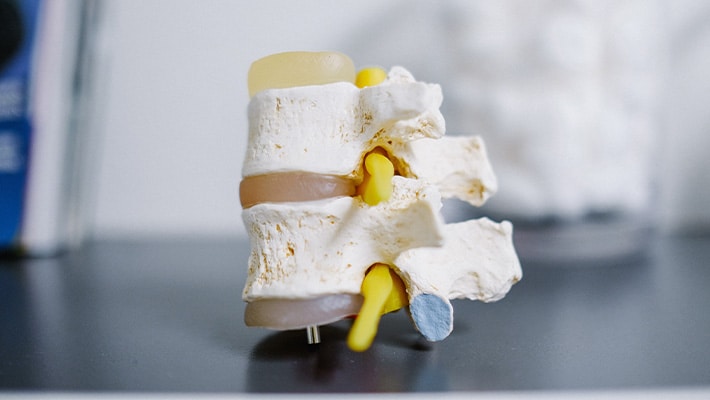Spinal Cord Injuries
Spinal cord injuries (SCIs) can be life-altering for victims and their families, causing extreme pain, loss of movement, and even permanent disability. In addition to the pain of a back injury, a spinal cord injury can damage nerve fibers and severely impact your central nervous system.
At Wilson Kehoe Winingham, our team of personal injury attorneys has made spinal cord injuries one of the primary areas of our practice for over 40 years. We can help with all aspects of spinal cord injury, including determining liability, estimating your losses, and recovering damages for your injury.
Contact us today for a free consultation.
Common Causes of Spinal Cord Injuries
A hard blow to the back, neck, or pelvis is the most common cause of spinal cord injuries. The trauma can fracture, compress, or dislocate one or more vertebrae, causing the spinal cord to swell. If not treated quickly, the brain’s ability to carry messages throughout the body can be permanently impaired.
Injuries of this nature can happen in a variety of circumstances, including:
- Motor vehicle accidents
- Workplace accidents
- Slips and falls
- Medical malpractice
- Farming accidents
- Defective products
Spinal Cord Injury Classification
Every spinal cord injury presents unique challenges and rehabilitation needs. The extent of functional recovery can vary widely depending on factors such as the severity of the injury, emergency response efforts, and the effectiveness of treatment and rehabilitation.
Medical providers may diagnose spinal cord injury after a car accident or other personal injury with a CT scan or MRI. Doctors typically separate spinal injuries into one of two categories:
- An incomplete spinal cord injury indicates partial damage to the spinal cord, which can leave some degree of sensation and control intact. The degree of feeling and mobility depends on the location of the trauma and the injury’s severity.
- A complete spinal cord injury marks a total loss of function below the point of injury. Paraplegia or tetraplegia are examples of complete spinal cord injuries.
Spinal cord injuries are classified into four levels based on the affected area of the spine and the resulting functional impairments. These levels are often described using the corresponding vertebrae:
- Sacral (S1-S5): Injuries at the sacral level primarily affect the hips, buttocks, genitals, and some leg functions. These injuries typically result in varying degrees of impairment in lower body function—including bowel and bladder control—and may also impact sexual function.
- Lumbar (L1-L5): Injuries at the lumbar level primarily affect the hips and legs. Paralysis can occur below the level of injury, potentially leading to paraplegia. However, lumbar injuries often result in better functional outcomes than higher-level injuries.
- Thoracic (T1-T12): Injuries at the thoracic level affect the chest and abdominal muscles and the legs. They can result in paraplegia, affecting the lower part of the body, including the trunk, legs, and pelvic organs. Functionality in the arms and hands is typically preserved.
- Cervical (C1-C8): Injuries at the cervical level affect the neck region and can result in varying degrees of paralysis, impacting the arms, hands, trunk, and legs. Higher cervical injuries (C1-C4) can lead to tetraplegia (also known as quadriplegia), affecting all four limbs and potentially resulting in respiratory complications or brain injury. Lower cervical injuries (C5-C8) may still lead to paralysis but typically spare some arm function.

Long-Term Effects of a Spinal Cord Injury
It can be difficult to know what to expect after a spinal injury, as it takes several months for the condition to stabilize. Patients can suffer a wide range of long-term consequences depending on the location and degree of the trauma. Individual factors, such as age, overall health, and access to rehabilitation, can also affect outcomes.
However, some common long-term effects include:
- Paralysis. Paralysis is often the most significant long-term effect of an SCI. Depending on the level of the injury, individuals may experience tetraplegia (paralysis of all four limbs) or paraplegia (paralysis of the lower body).
- Loss of sensation. SCI can lead to a loss of sensation below the level of injury. This loss of sensation may affect touch, temperature, and proprioception (awareness of body position).
- Loss of bowel and bladder control. Many individuals with SCI experience loss of bowel and bladder control, leading to issues such as urinary and fecal incontinence. Management often involves catheterization, bowel programs, surgery, and medications.
- Muscle atrophy and weakness. Lack of movement and sensory input can lead to muscle atrophy and weakness, increasing the risk of secondary complications such as pressure ulcers and joint contractures.
- Spasticity. Spasticity, or muscle stiffness and involuntary muscle contractions, is a common long-term effect of SCI. It can lead to pain, discomfort, mobility problems, and difficulty with self-care activities.
- Respiratory problems. Individuals with higher-level SCIs, particularly cervical injuries, may experience respiratory complications due to weakened or paralyzed respiratory muscles. This increases the risk of breathing problems and respiratory infections.
- Chronic pain. Chronic pain is prevalent among individuals with SCI and can result from nerve damage, musculoskeletal issues, and secondary complications such as pressure ulcers.
- Autonomic dysreflexia. Autonomic dysreflexia is a life-threatening condition affecting individuals with SCI at or above the T6 level. It is characterized by a sudden increase in blood pressure in response to certain stimuli below the level of injury, such as bladder or bowel distention.
- Secondary medical conditions. Spinal cord injury patients are overwhelmingly likely to develop secondary medical problems, such as bedsores, bladder infections, and lung infections.
In addition to the physical aspects, spinal cord injuries can cause significant psychological and emotional effects. The day-to-day hardships can result in depression, anxiety, grief, and adjustment difficulties. Collectively, these long-term effects can significantly impact an individual’s quality of life, independence, and participation in daily activities.
Types of Compensation for Spinal Injuries
Spinal cord injury victims and their families may be able to collect compensation from the person who caused the injury. The following economic and non-economic damages may be awarded:
- Medical expenses, including speaking and mobility equipment, ongoing therapy appointments, and accommodations necessary for daily living
- Lost wages and potential future earnings
- Pain and suffering for the victim’s physical and emotional trauma
The type and amount of damages awarded in a spinal cord injury case will depend on a number of factors, including:
- The nature and extent of the injury and how it affects the victim’s ability to function
- Whether the injury is temporary or permanent
- The aggravation of pre-existing condition or injury
- The disfigurement or deformity that results from the injury
- The reduced life expectancy the victim may have
Examples of Spinal Injury Cases
A spinal cord injury can have disastrous effects on a person’s life, health, and ability to earn a living. In 2015, professional jockey Oriana Rossi fell from her horse during a race on the Indiana Grand (now Horseshoe Indianapolis) track in Shelbyville. She suffered an incomplete spinal cord injury that may prevent her from walking or riding again.
Even if the victim’s suffering is extreme, insurers and negligent parties have some valid spinal cord injury defenses. Legal standards—such as comparative negligence and assumption of risk—can be used to deny or devalue a spinal injury claim. For this reason, it’s important to hire an attorney who has fought and won these kinds of battles.
For instance, WKW recently represented a young man rendered partially quadriplegic after striking his head on a dredge pipe in Lake Shafer. We successfully proved that the owner of the pipe was negligent, as no markings or signs were posted to warn of the pipe’s presence under the water when the injury occurred. After we obtained a verdict for our client at trial, the defendant mounted an unsuccessful appeal, and the Indiana Court of Appeals upheld the verdict.
Don’t Wait to Contact a Spinal Cord Injury Attorney
Victims only have a short time to seek compensation for spinal cord injuries in the state of Indiana. The statute of limitations on injury cases is just two years from the accident date, and many people need most or all of that time to focus on their treatment.
If you or a loved one has suffered from a spinal cord injury, we can advise you of your options at no cost to you. Our firm’s resources include a registered nurse on staff for a thorough understanding of the nature of an injury and the medical issues it presents.
Call us today at (317) 920-6400 or fill out our contact form to schedule a free and confidential initial consultation.
Table of Contents
Contact Us
Let WKW put our experience to work for you. Contact us for your free case evaluation.
Or, call us today at (317) 920-6400





